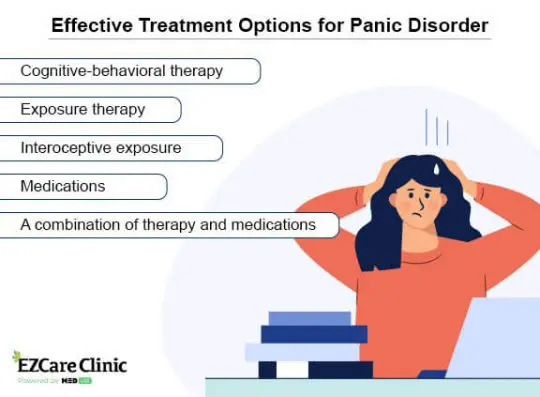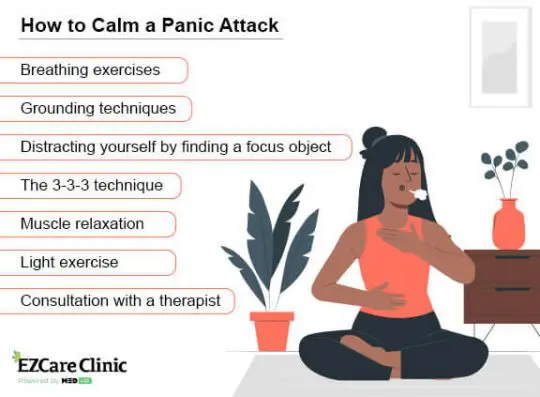Panic disorder is an anxiety disorder characterized by recurrent, unexpected panic attacks and persistent concerns or worries about having another attack or its repercussions. Panic disorder symptoms may include chest pain, heart palpitations, excessive sweating, shaking or trembling, abdominal distress, feeling cold or hot, numbness or tingling sensations, shortness of breath, dizziness, and a sense of impending doom or loss of control. The disorder can significantly interfere with a person’s daily life and may lead to agoraphobia and other mental health problems.
Treatments for panic disorder typically include therapy, medication, or a combination of both. They aim to reduce or eliminate panic attacks and the associated anxiety and improve the individual’s overall quality of life. This result is attained through several therapeutic and pharmacological interventions. Let’s review the more common ones below.
Panic disorder may come with different symptoms, but all of them can be managed using the right treatment.
Cognitive-behavioral Therapy
Cognitive-behavioral therapy (CBT) is a type of talk therapy that is widely considered the most effective treatment for panic disorder. The goals of CBT for panic disorder are to help the individual:
- Identify and challenge negative thought patterns and beliefs connected to panic attacks.
- Learn coping skills and relaxation techniques to manage symptoms during an attack.
- Gradually expose themselves to situations they have been avoiding due to fear of panic attacks (this is known as exposure therapy, a form of CBT).
CBT typically involves 12-20 weekly sessions, each lasting around 60 minutes. The following are some of the techniques that may be used during CBT sessions for panic disorder:
- Relaxation techniques. The individual is taught techniques such as deep breathing, progressive muscle relaxation, and visualization to help reduce physical symptoms of anxiety.
- Cognitive restructuring. The individual is taught to identify and challenge negative thoughts and beliefs related to panic attacks. The therapist will help them to develop more balanced and realistic thinking patterns.
- Exposure therapy. The individual is gradually exposed to feared situations or objects in a safe and controlled environment. The goal is to help them learn that the feared situation or object is not actually dangerous and to reduce the fear associated with it. Also, interoceptive exposure can be used. During the session, the individual is gradually exposed to physical sensations similar to the symptoms of panic attacks, such as rapid heartbeat or shortness of breath. The goal is to help the individual learn that these sensations are not dangerous and can be tolerated.

- Problem-solving and coping skills training. The individual is taught how to identify and solve problems related to panic disorder and how to develop coping strategies to manage symptoms.
It’s important to note that therapy for panic attacks is tailored to the individual’s specific needs and symptoms. The therapist will work with the patient to develop a treatment plan that addresses their specific challenges and goals.
Discuss your symptoms with a certified mental health professional from the comfort of your home.
Medication
Several classes of medications are used in treating panic disorder, including:
- Antidepressants
Selective serotonin reuptake inhibitors (SSRIs) and serotonin-norepinephrine reuptake inhibitors (SNRIs) are the most commonly prescribed medications for panic disorder. They increase the levels of certain neurotransmitters in the brain, such as serotonin and norepinephrine, which are responsible for reducing anxiety and improving your mood. SSRI examples include paroxetine (Paxil), sertraline (Zoloft), and fluoxetine (Prozac). Examples of SNRIs include venlafaxine (Effexor) and duloxetine (Cymbalta). Antidepressants typically take several weeks to reach their full effect. They can be effective in reducing the frequency and severity of panic attacks.
Tricyclic antidepressants and monoamine oxidase inhibitors (MAOIs) are also effective for panic disorder, but they are less frequently prescribed due to their potential side effects.
- Benzodiazepines
These medications are used to reduce anxiety and promote relaxation. They work by increasing the activity of an inhibitory neurotransmitter called GABA in the brain. Examples of benzodiazepines include alprazolam (Xanax), clonazepam (Klonopin), and lorazepam (Ativan). Benzodiazepines can effectively reduce the symptoms of panic attacks in the short term. However, they have a higher risk of dependence and are generally only used for short-term relief of symptoms.
- Beta-blockers
These medications are typically used to treat high blood pressure, but they can also reduce some physical symptoms of panic attacks, such as rapid heartbeat and trembling. Examples of beta-blockers include propranolol (Inderal) and atenolol (Tenormin).
It’s important to note that medication treatment for panic disorder should be supervised by a healthcare professional such as a psychiatrist or a primary care physician. The choice of medication and dosage will depend on the individual’s specific symptoms and medical history.

Combination of the Therapy and Medication
When used together, CBT and medication can complement each other and provide a more comprehensive treatment approach. Medication can help to reduce the symptoms of panic attacks, making it easier for the individual to participate in therapy and to practice the skills and strategies learned during the sessions.
On the other hand, therapy can help the individual to understand and manage the underlying psychological and emotional factors that contribute to their panic disorder, which can help to prevent relapse once the medication is discontinued.
Additionally, self-care practices such as exercise, good nutrition, adequate sleep, and an excellent support system can help manage the disorder.
Conclusion
Panic disorder is a treatable condition with different treatment options available. The most effective panic disorder treatments are therapy, medication, and their combination. Cognitive-behavioral therapy aims to help individuals change their thoughts, beliefs, and behaviors related to panic attacks. Medications such as antidepressants, benzodiazepines, and antihistamines may also be prescribed to help reduce the frequency and severity of panic attacks.
It’s important to note that treatment for panic disorder should be tailored to the individual’s specific needs and symptoms. Working closely with a mental health professional to develop a treatment plan that addresses particular challenges and goals is vital.
Related Links
- ANXIETY AT NIGHT
- CHEST PAIN TREATMENT
- anxiety disorder florida
- anxiety disorder new york
- anxiety disorder texas
- anxiety disorders california
- ANXIETY HEADACHE
- ANXIETY MEDICATIONS FOR YOU
- ANXIETY MEDS FOR DOGS
- ANXIETY DISORDER TEST
- ANXIETY THERAPIST
- ANXIETY TREATMENT CENTERS
- ANXIETY MEDICATIONS
- social anxiety test
- treatment for social anxiety
- ANXIETY TREATMENT WITHOUT MEDICATION



